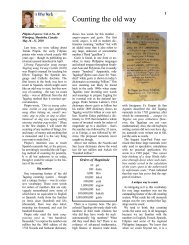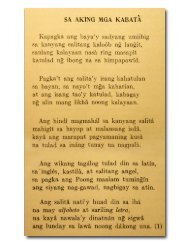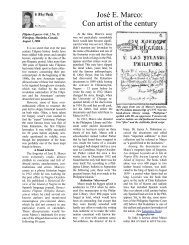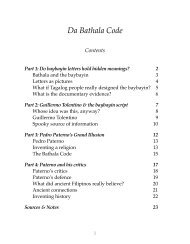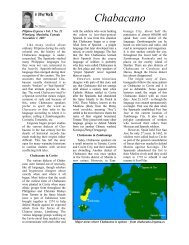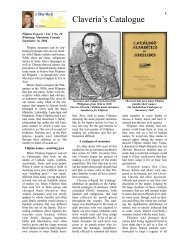Maharlika and the ancient class system - Pilipino Express
Maharlika and the ancient class system - Pilipino Express
Maharlika and the ancient class system - Pilipino Express
You also want an ePaper? Increase the reach of your titles
YUMPU automatically turns print PDFs into web optimized ePapers that Google loves.
<strong>Maharlika</strong> <strong>and</strong> <strong>the</strong> <strong>ancient</strong> <strong>class</strong> <strong>system</strong><br />
<strong>Pilipino</strong> <strong>Express</strong> • Vol. 2 No. 20<br />
Winnipeg, Manitoba, Canada<br />
October 16 - 31, 2006<br />
We don’t hear <strong>the</strong> word <strong>Maharlika</strong><br />
very much anymore. Its origin<br />
goes all <strong>the</strong> way back to <strong>the</strong><br />
<strong>ancient</strong> language of India called<br />
Sanskrit, from <strong>the</strong> word, maharddhika,<br />
meaning, “a man of<br />
wealth, knowledge or ability.”<br />
Today it is generally accepted to<br />
mean “nobility or aristocracy.”<br />
The venerable Tagalog dictionary<br />
of Leo James English gives us<br />
this example: Ang mga harì at<br />
prinsipe ay kabilang sa mga maharlikâ.<br />
[Kings <strong>and</strong> princes belong<br />
to <strong>the</strong> nobility.]<br />
That’s <strong>the</strong> modern definition, but<br />
back in <strong>the</strong> days when <strong>the</strong>re really<br />
was a maharlika <strong>class</strong> in <strong>the</strong> Philippines,<br />
it was actually a lower<br />
<strong>class</strong> of nobility that served <strong>the</strong><br />
datus, or chiefs, in times of war.<br />
The maharlikas belonged to <strong>the</strong><br />
“kings <strong>and</strong> princes” <strong>and</strong> not <strong>the</strong><br />
o<strong>the</strong>r way around.<br />
Marcos’ maharlika<br />
We can thank former dictator<br />
Ferdin<strong>and</strong> Marcos, mainly, for our<br />
misunderst<strong>and</strong>ing of this word<br />
today. “<strong>Maharlika</strong> culture” was his<br />
propag<strong>and</strong>a tool for promoting<br />
nationalism during <strong>the</strong> days of <strong>the</strong><br />
“New Society.” The word became<br />
very fashionable <strong>and</strong> was used in<br />
naming streets, buildings, banquet<br />
halls, villages <strong>and</strong> cultural groups.<br />
Marcos named a highway, a<br />
broadcast company <strong>and</strong> <strong>the</strong> reception<br />
area of Malacañang Palace,<br />
<strong>Maharlika</strong>. He even toyed with <strong>the</strong><br />
idea of renaming <strong>the</strong> whole country<br />
as <strong>Maharlika</strong>.<br />
Marcos’ fascination with <strong>the</strong> term<br />
apparently began in World War II<br />
when he claimed to have comm<strong>and</strong>ed<br />
a guerrilla force of over<br />
8000 men that he called <strong>the</strong> <strong>Maharlika</strong><br />
unit. His claims were<br />
proved false in 1985.<br />
It’s ironic that Marcos’ first use<br />
of <strong>the</strong> word maharlika was quite<br />
appropriate because he only used<br />
it to name a group of soldiers (albeit<br />
fictitious soldiers) ra<strong>the</strong>r than<br />
an entire aristocracy or country.<br />
An upper <strong>class</strong> Tagalog couple of <strong>the</strong> early colonial era<br />
From a painting in <strong>the</strong> Boxer Codex<br />
The maharlikas were just one<br />
rank in <strong>the</strong> <strong>ancient</strong> <strong>class</strong> <strong>system</strong> of<br />
<strong>the</strong> Tagalogs, which was a little<br />
more convoluted than our western<br />
idea of aristocrats <strong>and</strong> commoners.<br />
This <strong>class</strong> <strong>system</strong> was <strong>the</strong> norm in<br />
o<strong>the</strong>r parts of <strong>the</strong> Philippines, too,<br />
though <strong>the</strong> names of <strong>the</strong> <strong>class</strong>es<br />
varied slightly.<br />
The <strong>ancient</strong> <strong>class</strong> <strong>system</strong><br />
Maginoo – During <strong>the</strong> precolonial<br />
era, <strong>the</strong> maginoo <strong>class</strong> was<br />
<strong>the</strong> top of Tagalog society. Men <strong>and</strong><br />
women of this <strong>class</strong> were generally<br />
referred to with <strong>the</strong> respectful title<br />
of Ginoo. Individually, <strong>the</strong> terms,<br />
Gat, meaning Lord, or Dayang,<br />
meaning Lady, preceded names as<br />
in, Gat Buka (now a town in Bulakan)<br />
<strong>and</strong> Dayang Angkatan who<br />
was mentioned in <strong>the</strong> Laguna<br />
Copperplate Inscription.<br />
A panginoon was an especially<br />
wealthy maginoo who owned much<br />
property <strong>and</strong> valuable l<strong>and</strong>. A panginoon<br />
was addressed with <strong>the</strong><br />
shortened honorific, poon, which<br />
could be translated into English as<br />
milord or milady. Aba poon meant,<br />
“Greetings, milord/milady” <strong>and</strong><br />
Oo, poon meant, “Yes, sir/ma’am.”<br />
Poon survives to this day as <strong>the</strong><br />
term of respect, po.<br />
A datu, or chief, was a maginoo who<br />
had followers <strong>and</strong> who ruled beyond<br />
his immediate household, over whole<br />
communities. This term was used in<br />
<strong>the</strong> Visayas as well as Luzon. A datu<br />
with power over a large area held <strong>the</strong><br />
title Lakan or Rajah, a Hindu word<br />
brought from Malaysia. When <strong>the</strong><br />
Spaniards arrived in <strong>the</strong> Manila area<br />
in 1570, <strong>the</strong>re was a Banaw Lakan<br />
Dula in Tondo <strong>and</strong> an Ache Rajah<br />
(Ladyang) Mat<strong>and</strong>a in Manila.
Paul Morrow • In O<strong>the</strong>r Words • The <strong>Pilipino</strong> <strong>Express</strong> • October 16 - 31, 2006<br />
Timawa – The timawa <strong>class</strong> were<br />
free commoners of Luzon <strong>and</strong> <strong>the</strong><br />
Visayas who could own <strong>the</strong>ir own<br />
l<strong>and</strong> <strong>and</strong> who did not have to pay a<br />
regular tribute to a maginoo, though<br />
<strong>the</strong>y would, from time to time, be<br />
obliged to work on a datu’s l<strong>and</strong> <strong>and</strong><br />
help in community projects <strong>and</strong><br />
events. They were free to change<br />
<strong>the</strong>ir allegiance to ano<strong>the</strong>r datu if<br />
<strong>the</strong>y married into ano<strong>the</strong>r community<br />
or if <strong>the</strong>y decided to move.<br />
<strong>Maharlika</strong> – Members of <strong>the</strong><br />
Tagalog warrior <strong>class</strong> known as<br />
maharlika had <strong>the</strong> same rights <strong>and</strong><br />
responsibilities as <strong>the</strong> timawa, but<br />
in times of war <strong>the</strong>y were bound to<br />
serve <strong>the</strong>ir datu in battle. They had<br />
to arm <strong>the</strong>mselves at <strong>the</strong>ir own expense,<br />
but <strong>the</strong>y did get to keep <strong>the</strong><br />
loot <strong>the</strong>y won – or stole, depending<br />
on which side of <strong>the</strong> transaction<br />
you want to look at. Although <strong>the</strong>y<br />
were partly related to <strong>the</strong> nobility,<br />
<strong>the</strong> maharlikas were technically<br />
less free than <strong>the</strong> timawas because<br />
<strong>the</strong>y could not leave a datu’s service<br />
without first hosting a large<br />
public feast <strong>and</strong> paying <strong>the</strong> datu<br />
between 6 <strong>and</strong> 18 pesos in gold – a<br />
large sum in those days.<br />
Alipin – Today, <strong>the</strong> word alipin<br />
(or oripun in <strong>the</strong> Visayas) means<br />
slave <strong>and</strong> that’s how <strong>the</strong> Spaniards<br />
translated it, too, but <strong>the</strong> alipins<br />
were not really slaves in <strong>the</strong> western<br />
sense of <strong>the</strong> word. They were<br />
not bought <strong>and</strong> sold in markets with<br />
chains around <strong>the</strong>ir necks. A better<br />
description would be to call <strong>the</strong>m<br />
debtors. They could be born<br />
alipins, inheriting <strong>the</strong>ir parents’<br />
debt, <strong>and</strong> <strong>the</strong>ir obligations could be<br />
transferred from one master to ano<strong>the</strong>r.<br />
However, it was also possible<br />
for <strong>the</strong>m to buy <strong>the</strong>ir own freedom.<br />
A person in extreme poverty might<br />
even want to become an alipin voluntarily<br />
– preferably to relatives<br />
who saw this as a form of assistance<br />
ra<strong>the</strong>r than punishment.<br />
There were two kinds of alipins:<br />
Aliping namamahay – or a<br />
house-holding alipin, could hardly<br />
be called a slave at all. He was<br />
more like what we call a serf in<br />
English. A namamahay was usually<br />
an alipin who had received a piece<br />
of l<strong>and</strong> from his maginoo master. In<br />
return, he was required to h<strong>and</strong><br />
over a portion of what <strong>the</strong> l<strong>and</strong><br />
produced as a tribute <strong>and</strong> to occasionally<br />
work on his master’s l<strong>and</strong>.<br />
Alipin sa gigilid – The people<br />
near <strong>the</strong> bottom of society were<br />
known by <strong>the</strong> scornful term, alipin<br />
sa gigilid. In pre-colonial times <strong>the</strong><br />
gilid was <strong>the</strong> area behind <strong>and</strong> below<br />
<strong>the</strong> house where <strong>the</strong> toilet was located.<br />
These alipins were single<br />
men <strong>and</strong> women who worked in<br />
<strong>the</strong>ir master’s homes, tending <strong>the</strong><br />
gilid, among o<strong>the</strong>r chores. They<br />
were completely dependent for<br />
food <strong>and</strong> shelter, but if <strong>the</strong>y could<br />
make some money on <strong>the</strong> side,<br />
<strong>the</strong>y were allowed to keep some<br />
of it, <strong>and</strong> if <strong>the</strong>y managed to save<br />
enough, <strong>the</strong>y could buy <strong>the</strong>ir way<br />
up to namamahay or even timawa<br />
status. If a man wanted to get<br />
married, his master would usually<br />
set him up as an aliping namamahay<br />
with his own home <strong>and</strong> a<br />
patch of l<strong>and</strong>, though this was<br />
rarely done for women.<br />
The people who bore <strong>the</strong> greatest<br />
stigma in society were <strong>the</strong> alipins<br />
who were indebted to o<strong>the</strong>r alipins. A<br />
sa gigilid of an aliping namamahay<br />
was called a bulisik, which meant<br />
vile <strong>and</strong> contemptible. Even lower<br />
was <strong>the</strong> bulislis who was a sa gigilid<br />
indebted to ano<strong>the</strong>r sa gigilid. The<br />
vulgar name meant that <strong>the</strong>se alipins<br />
were so vulnerable that it was like<br />
<strong>the</strong>ir genitals were exposed. In modern<br />
terms we might say <strong>the</strong>y “had<br />
<strong>the</strong>ir pants down,” though bulislis<br />
really means, “lifted skirt.”<br />
The only people lower than <strong>the</strong><br />
bulislis were slaves who were<br />
brought from o<strong>the</strong>r communities or<br />
who were captured in war. They<br />
were considered non-persons until<br />
<strong>the</strong>y were accepted into <strong>the</strong> community.<br />
Once accepted, <strong>the</strong>y had<br />
<strong>the</strong> same rights as o<strong>the</strong>r alipins.<br />
E-mail <strong>the</strong> author at:<br />
feedback@pilipino-express.com or<br />
visit www.mts.net/~pmorrow for<br />
more about Filipino history <strong>and</strong><br />
language.



